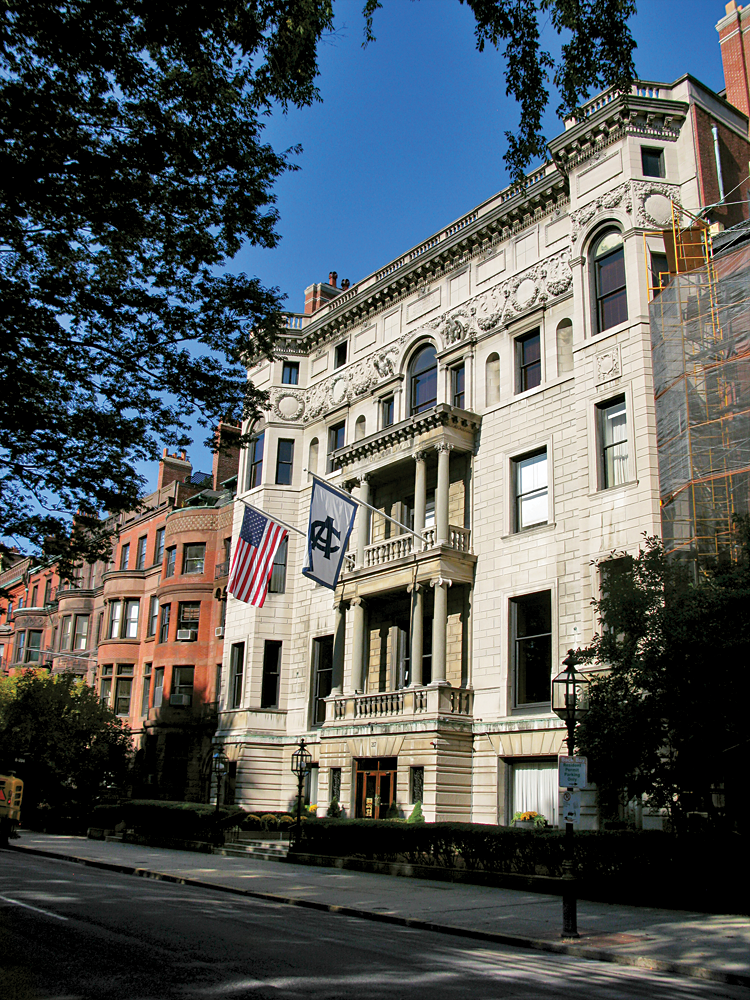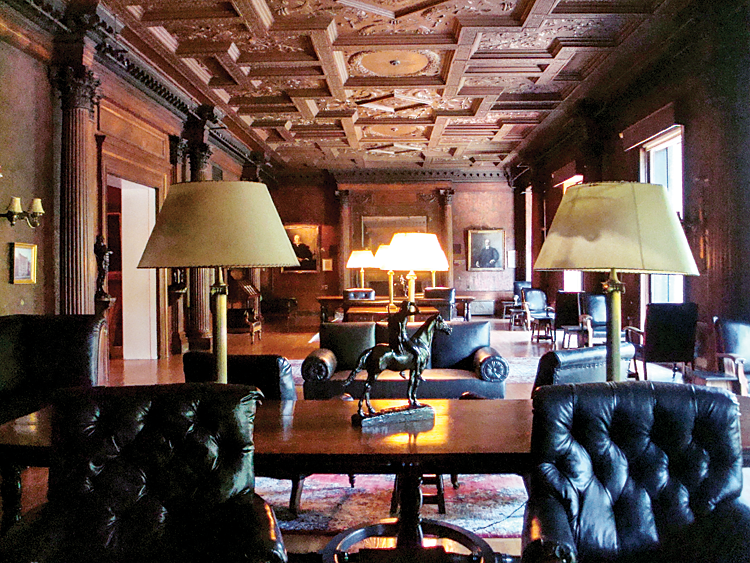Boston’s Algonquin Club
One of the earliest recorded meetings of the Algonquin Club’s executive committee resulted in a vote to build “an entirely new clubhouse.” (Ref. 1) The first purpose-built clubhouse in the City of Boston and one of the earliest in the United States, the construction of the Algonquin Club marked a radical departure for social clubs from the standard reuse of former private residences. When the building was completed at 217 Commonwealth Avenue in 1888 (Fig. 1), the press hailed it as “the most perfectly appointed clubhouse in America.” (Ref. 2) The continued preservation of its original layout, interior fittings, furnishings, and collections allows a glimpse into the Gilded Age.
McKim, Mead & White won the architectural design competition initiated by the club. At the time, the relatively new firm, still run as an atelier, had been given a number of important commissions, including the stylish residence of the Algonquin Club’s first president John Forrester Andrew (1850–1895), whose portrait hangs in the Reading Room. At the same time, Charles Follen McKim (1847–1895), one of the firm’s partners, was an active member of the club.
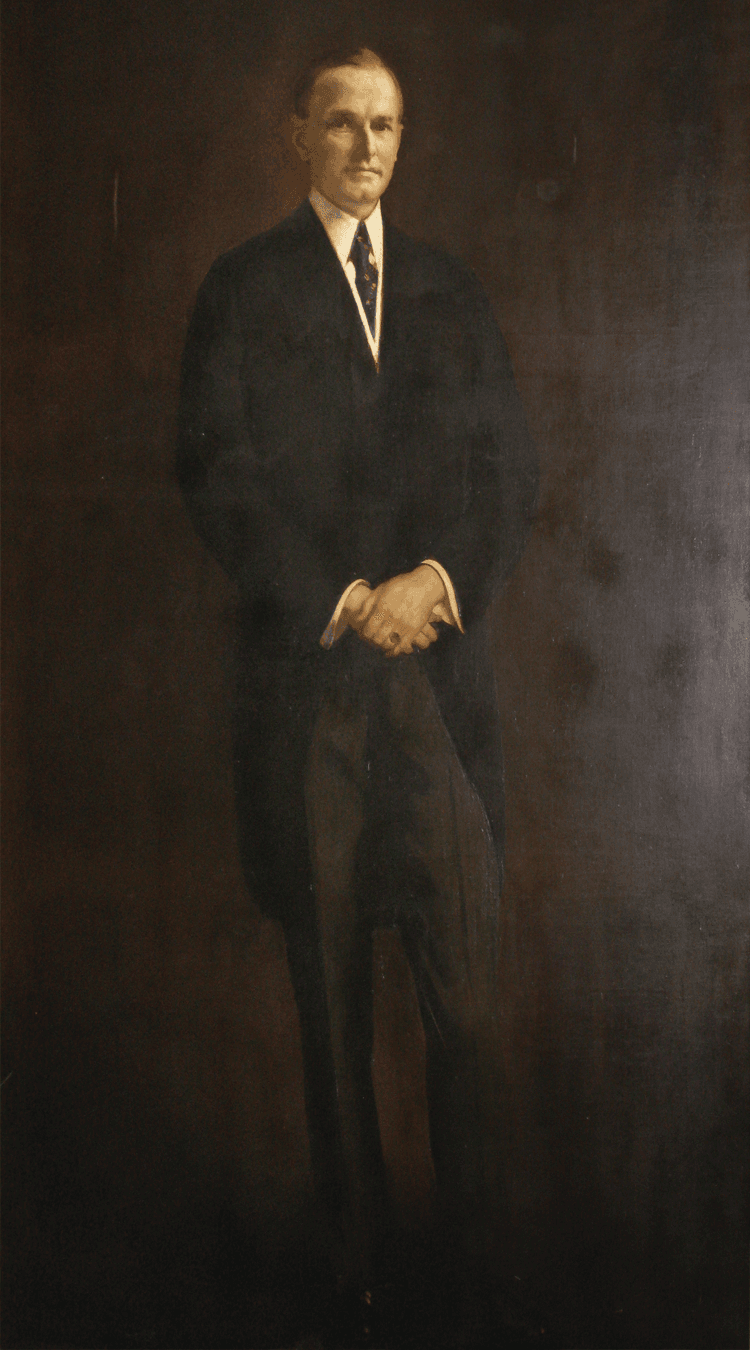
- Fig. 3: Edmund C. Tarbell (American, 1862–1938),
Portrait of President Calvin Coolidge, 1926.
Oil on canvas, 88 x 33 inches.
Signed upper left. Walfred Thulin frame.
President Coolidge was a celebrated member of the Algonquin Club. The club purchased this full-length portrait through subscription in 1927. The Boston Globe reported in 1938 “One of the most difficult portraits that Tarbell ever painted was that of President Coolidge for the Algonquin Club. He said Coolidge while posing, looked like a boy one moment and the next moment his expression would change into that of a grave and stern man. Most of the time the President was absolutely expressionless. But for all that he was genial.” The portrait has remained in a prominent location within the club since its purchase; it is presently hung in the second-floor foyer. Tarbell was Dean of the Boston School of Painters in the early 1900s, and Chairman of the club’s Art Committee.
Construction of the six–story, white Indiana limestone clubhouse, located in Boston’s Back Bay, began almost immediately. The design represents an early example of the Italian Renaissance Revival style, which, over the next two decades, became the hallmark of city club architecture in the United States.
Evidenced by the clubhouse’s overall design is the clear collaboration between architect and artisan in the embellishment of interior spaces. Shortly before opening the clubhouse, it was voted that “the committee on carpets and hangings confer with the committee on furniture so that there may be harmony in tone and color.” (Ref. 3) Original interior finishes, garnet glaze-painted walls, marbles, bronze work, and woods remain intact (Fig. 2). Rooms within the clubhouse include custom-made furniture by Alfred H. Davenport (1845–1905), who ran a highly successful custom design furniture company and interior design business in Boston during the late nineteenth century. He was an early member of the club and worked closely with McKim, Mead, & White in providing furniture to complement many of their concepts.
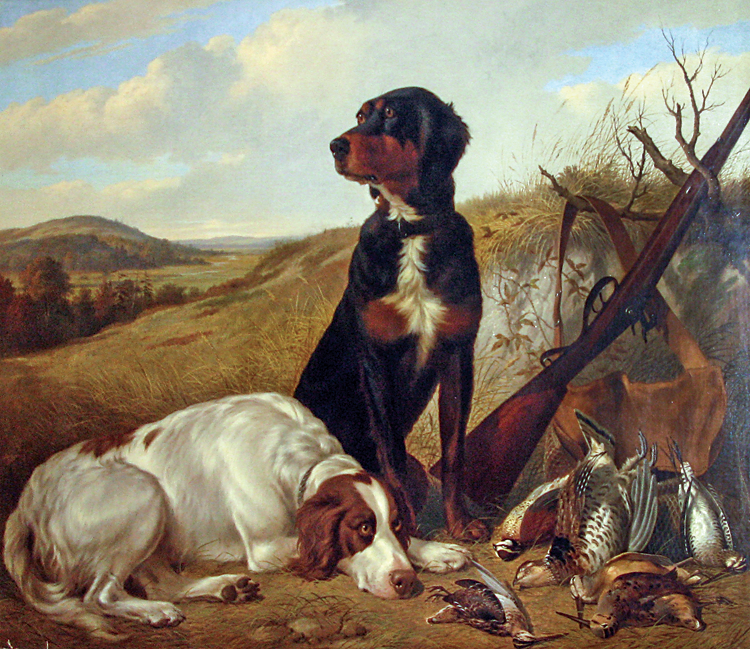
- Fig. 4: Thomas Hewes Hinckley (American, 1813–1896), Setters, Shotgun, and Game, 1887.
Oil on canvas, 36 x 48 inches.
Signed and dated (at lower center): T. H. Hinckley / 1887.
Thomas Hewes Hinckley was born in Milton, Massachusetts. In 1829, he went to Philadelphia where he became a merchant’s apprentice and, in the evenings, attended a class in drawing at the home of the artist, John Mason. In 1833, he returned to Milton where he succeeded in the painting of domestic and game animals for wealthy local gentleman farmers, as well as landscapes highlighted by prize stock.
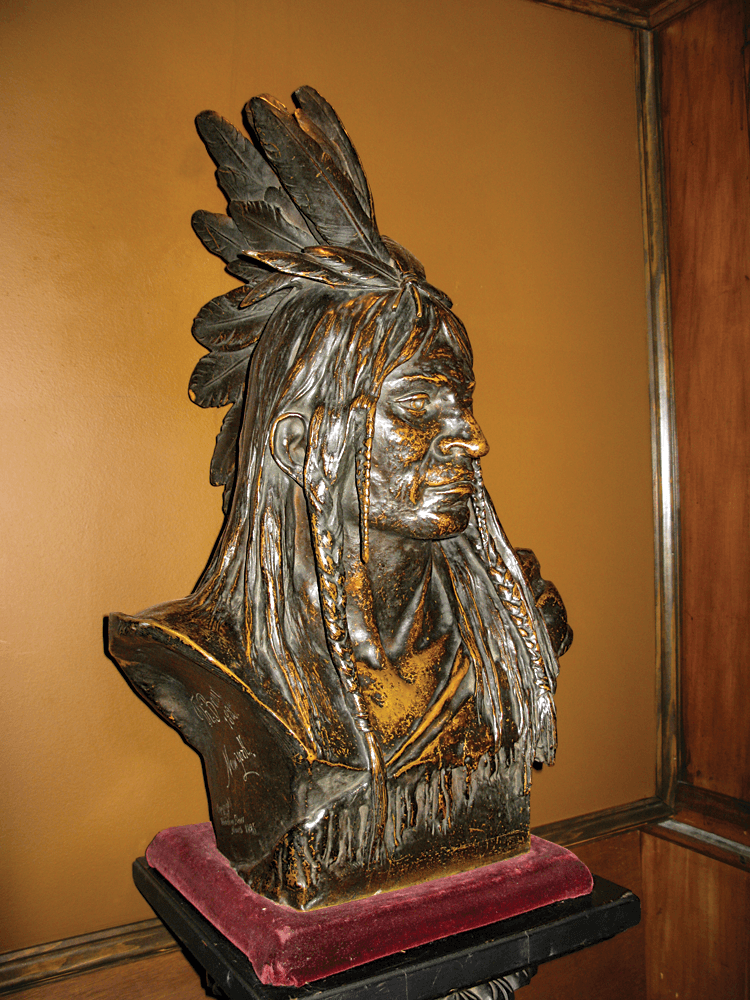
- Fig. 5: Theodore Baur (French, 1835–1894),
Bust of Crazy Horse, 1885.
Bronze, 27½ in. high.
Signed, dated, and inscribed (on proper-right truncation): Th. Baur / New York / 1885 / Copyright / by / Theodore Baur / 1885.
A respected sculptor in American art circles in the late nineteenth century, Theodore Baur created many decorative pieces for public buildings and modestly scaled bronzes for private collectors. Among his Native American subjects was this idealized image of the Lakota warrior known as Chief Crazy Horse (ca. 1840–1877), who was instrumental in defeating Custer at the Battle of Little Bighorn. Depicted in the prime of his life wearing traditional braids and an eagle-feather headdress, the image is in keeping with the popular romantic view of Native Americans during the late nineteenth century. First cast in 1885, this is a rare example of a sculptural image of a Native American subject.
The Algonquin Club has a rich history in collecting fine art, much of which dates to when Edmund C. Tarbell (1862–1938) chaired its art committee. Tarbell was a member of the Ten American Painters, a group that “fundamentally altered the relationship of the artist to his audience” (Ref. 4) and stressed cohesiveness in exhibition design and installation. Through Tarbell’s influence and guidance, the club’s art collection includes important works by late–nineteenth and early–twentieth–century American and European artists. Portraits by Tarbell himself hang in the main rooms of the club (Fig. 3), including the Reading Room, where his work is near large Hudson River School paintings featuring pastoral scenes of sheep and cattle by James MacDougal Hart (1828–1901) and sporting dogs by Thomas Hewes Hinckley (1813–1896) (Fig. 4). Dutch genre paintings and New England maritime paintings by Marshall Johnson (1850–1921) hang between bronzes of Native Americans by Cyrus Edwin Dallin (1861–1944). A circa-1870 carved and polychrome tobacco store figure of a Native American, by Julius Theodore Melchers (1829–1909), is prominently placed in the main stairwell near Theodore Baur’s Bust of Crazy Horse (Fig. 5).
Based on surviving inventories, much of the furniture and art remains in its original location and represents a rare look into the tastes of a bygone era. This opportunity is due in large part to the club’s volunteer committees and its members, who have understood the significance of the clubhouse and its collections. A recently formed organization, the Algonquin Club Foundation, is charged with creating access for study of the clubhouse and for its continued preservation.
For more information about the club, its history, interiors, and art, and for details on the privileges and benefits of membership, including dining in one of Boston’s top restaurants, call 617.266.2400 or visit www.algonquinclub.com.
Benjamin Bergenholtz is a founding board member of the Algonquin Club Foundation.
This article was originally published in the Winter 2014 issue of Antiques & Fine Art magazine, a fully digitized version of which is available at afamag.com. AFA is affiliated with Incollect.
1. Executive Committee Meeting Minutes, April 5, 1886. Algonquin Club archives.
2. “Algonquins: Boston’s New Club House Dedicated,” Boston Daily Globe (November 9, 1888).
3. Executive Committee Meeting Minutes, March 28, 1888. Algonquin Club archives.
4. Ulrich W. Hiesinger, Impressionism in America: The Ten American Painters (Prestel-Verlag, Meunchen, 1991).















